
To innovate, first deprecate.
Building on Magnitudes of exploration, which discusses an approach to balancing platform standardization and exploring for new, superior platforms, I wanted to also look into this problem from a systems thinking perspective, similar to my previous examination of Why limiting work-in-progress works.
Supporting Innovation notebook is on Github and Binder.
Standardization
Starting our we model a company that doesn’t adopt new platforms, instead choosing to place their entire investment budget into their existing platforms.
PlatformInvestment(100)
Platforms(10)
[Potential] > Platforms @ 0
[Potential] > PlatformInvestment @ 5
[Potential] > Progress @ PlatformInvestment / Platforms
As their platforms over time, they get faster and faster over time.
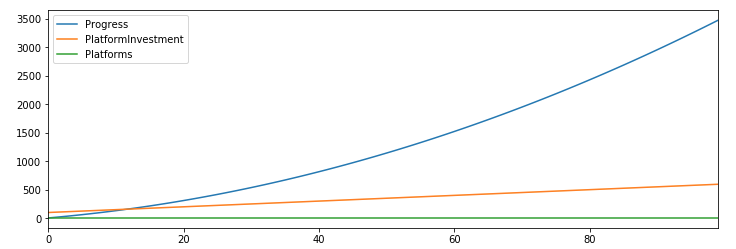
It’s not aflashy path to success, but it is a path to success.
Exploring a bit
Changing things up, let’s consider an organization that adds more platforms over time, splitting their investment across those platforms.
PlatformInvestment(100)
Platforms(10)
[Potential] > Platforms @ 1
[Potential] > PlatformInvestment @ 5
[Potential] > Progress @ PlatformInvestment / Platforms
Hmm, I have a bad feeling about this one.

Comparing this approach with the standardization one above, things don’t work out very well for us, with this naive approach to exploration causing us to spread our investment further and further over time.
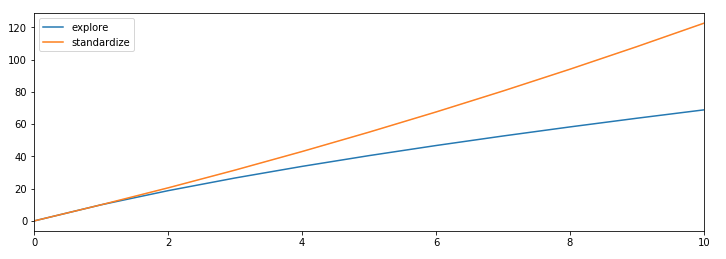
Certainly this experience might resonates to some folks, but it’s also a bit unrealistic. Who keeps every platform they’ve ever considered using?
Deprecation
So let’s factor in deprecation, getting rid of old platforms as we add in new ones.
PlatformInvestment(100)
Platforms(10)
[Potential] > Platforms @ 1
Platforms > Deprecated @ 1
[Potential] > PlatformInvestment @ 5
[Potential] > Progress @ PlatformInvestment / Platforms
Now we’re exactly back to the results we got from standardization, albeit with a bit more complexity.

That said, we hopefully not adopting platforms which are in every way equivalent to our previous platforms.
Innovation
Now let’s factor in the idea of innovation, which is to say that we’re being careful to only adoption new platforms that are actually better than our existing platforms in some way
PlatformInvestment(100)
Platforms(10)
InvestmentRate(5)
[Potential] > Platforms @ 1
Platforms > Deprecated @ 1
[Potential] > InvestmentRate @ 1
[Potential] > PlatformInvestment @ InvestmentRate
[Potential] > Progress @ PlatformInvestment / Platforms
and things are starting to look good for us
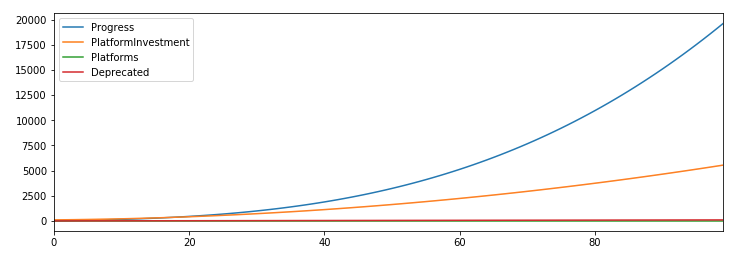
If we compare these approaches, one which focuses on standardization against another which innovates–adding better platforms over time–the winning approach is clear.
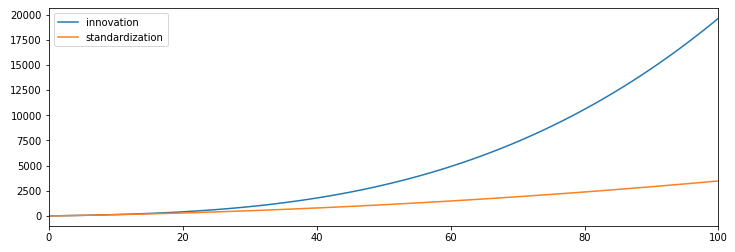
However, note that we’re being very rigorous about deprecating existing platforms at the rate that we’re adopting them, to avoid spreading our investment across more tools.
Hmm, that’s a bit optimistic.
Deprecation rate
What if, as is often the case in companies with a decentralized approach to adopting new technologies, we find ourselves adopting better technologies–we’re still innovating–but get less rigorous about deprecation?
Let’s compare two models here, the first which has us introducing and deprecating at the same rate:
PlatformInvestment(150)
Platforms(10)
InvestmentRate(15)
[Potential] > Platforms @ 3
Platforms > Deprecated @ 3
[Potential] > InvestmentRate @ 1
[Potential] > PlatformInvestment @ InvestmentRate
[Potential] > Progress @ PlatformInvestment / Platforms
The second model is identical but only deprecates two platform each round, instead of quite matching the three new introduced platforms.
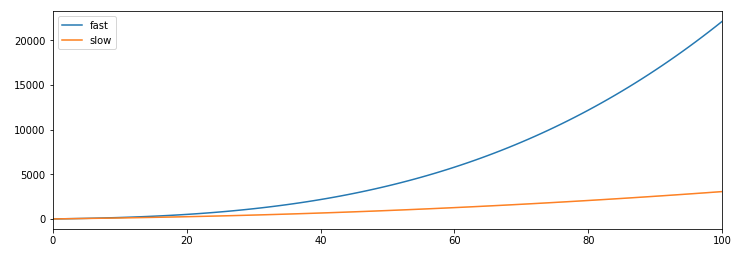
We can see that deprecating early is essential to gaining the largest upside of explorations, even if every tool you adopt is superior to your previous selections. Even more damningly, let’s compare standardization against slow deprecation.
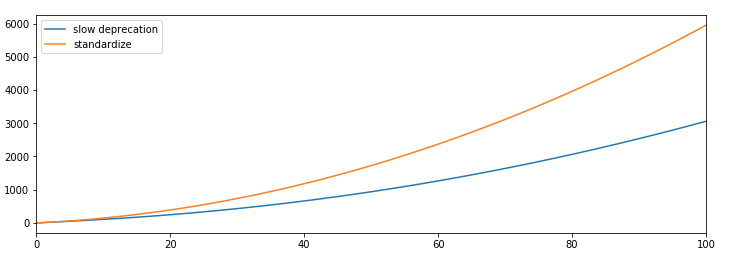
I think this is a startling result! If we aren’t mature about deprecating old technologies when we adopt new ones, then it’s better to skip the whole exploration bit and standardize on what we already have.
Back in reality
Looking at these results, note that these are results over one hundred rounds, and assuming we can explore and deprecate technologies over a single round. For most companies, that would mean a round is at least six months, and potentially much longer.
- There is still something important to learn from this exercise:
- if you want to become a truly innovative company, the two fundamental skills are determining if a new technology is significantly superior to existing ones, and deprecating old technology.